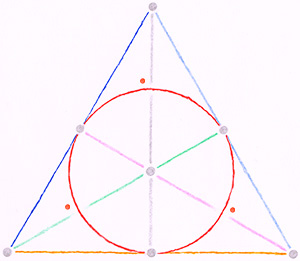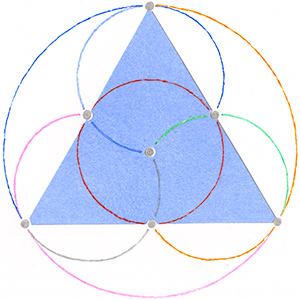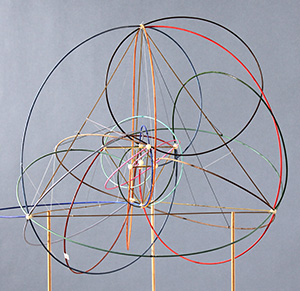- Familiar Fano Plane
- Non-intersective Modifications
- Motivation
- Contact
1. Familiar Fano Plane
One of the fundamental figures of Finite Geometry, the classic Fano Plane, is not really a plane. Obviously it includes three intersections which have to be declared invalid, otherwise the diagram would violate the axioms of Projective Planes. Hence it seems to have a concealed spatial quality.

Fano Plane
7 points  , 7 lines ( = colours)
, 7 lines ( = colours)
3 points on every line
3 lines through every point
Each line meets every other line exactly once
Any two points have exactly one line in common
Deficiency:
3 intersections have to be declared invalid 
Are such undesirable intersections unavoidable? Or is it possible to design a plane figure without them? The following solutions I found through an artistic approach, though I did not succeed with freehand attempts. I had to write Python programs using recursive procedures and Gauss Algorithm for systems of linear equations with 7 unknowns. After elimination of isomorphy with respect to rotational and mirror symmetry, there still remain five solutions as shown in the following.
2. Non-intersective Modifications
Each of Figure 1-5 is made up of 15 elements of a circle. In any case, there is one closed path (red circle) part of the figure. Without this entire circle symmetry would be impossible. The location of the red circle is either internal or on the periphery of the figure.

Figure 1
Elements of 1/3 circle
and 1/6 circle

Figure 1a
The arrangement of points correspond
to their position in the common Fano Plane

Figure 2
Elements of 1/3 circle,
straight lines corresponding
to the bisectors of Fano Plane

Figure 3
Elements of 1/3 circle and
1/2 circle, straight lines corresponding
to the edges of Fano Plane

Figure 4
Elements of 1/2 circle, 1/3 circle and
1/6 circle. Internal closed circle.

Figure 5
Elements of Figure 4, closed
circle on the periphery.
The step-by-step development of the samples above, cutting down millions of variants, is shown in my publication "Fünf Varianten der Fano-Ebene", which also contains further details of the computational approach. I attempted to illustrate the stages of invention in a rather poetic way, leaving all technical terms for the last chapter of the essay. And I do not deny various analogies between the design process and issues of evolutionary theory in general.
3. Motivation
While specializing on design theory as an architect, I came into contact with Finite Geometry through the lectures of Prof. H. Lenz, Berlin. Since then, I have been passionate about building spatial models of Projective Planes. Solutions can only be found by complicated computational procedures. What has kept me going, is the aesthetical dimension of the subject.

In addition to the Fano Plane,
I have a good look at Projective Planes of
extended order.
A non-intersective 3D-model
of order 3 (13 points and 13 lines)
I presented at Bridges Conference 2016, Jyväskylä.
It was winner of the Innovation Award by people's choice at the art exhibition.
4. Contact

Albrecht Wintterlin
Crellestraße 25
10827 Berlin
Phone 030-7849781
witte-wintterlin@t-online.de
"Fünf Varianten der Fano-Ebene"
Berlin 2016, Kreispunkt Verlag
ISBN 978-3-00-052200-0
26 S., 39 Abb., 12.50 Euro.
(orders with the author)